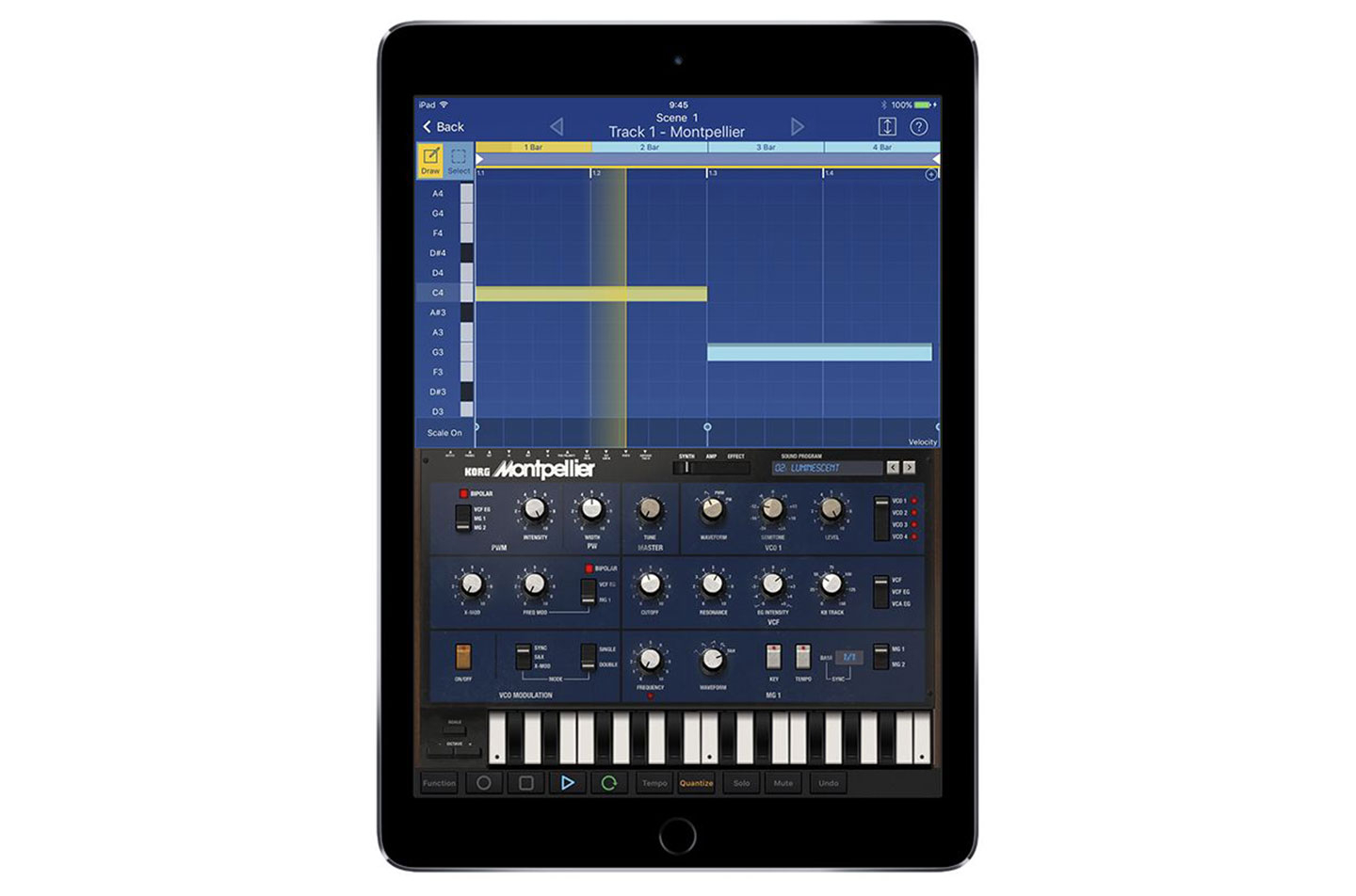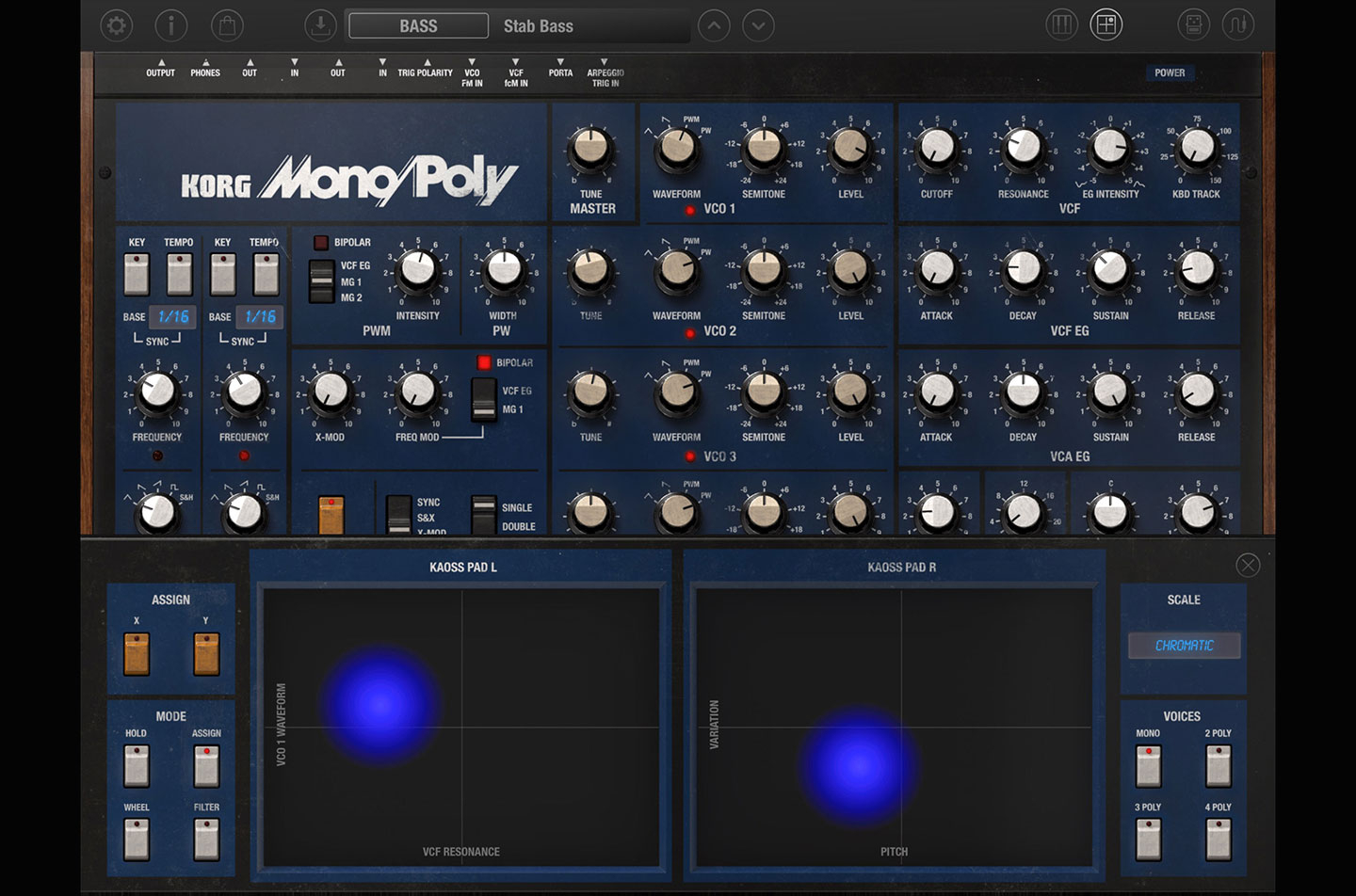- Korg's original hardware versions of the Mono/Poly and PolySix have been fodder for comparison since 1981. The rivalry continued into the 21st century when they found new life as VST plug-ins in Korg's Legacy Collection. Fast forward a decade, and the two are facing off once again as iOS apps.
One important difference is the devices they support. The iMono/Poly can only run on iPad Air or later, perhaps in order to adhere to Apple's 64-bit standard. Being a universal device, iMono/Poly can also run on the iPhone, with the iPhone 5s being the minimum level supported. This may be a bit of a let down for folks still using an iPad 4 in the studio but this type of restriction is only going to become more common as time goes by.
When it comes to connectivity with other iOS apps, the iMono/Poly has the edge. It supports both Inter-App Audio and Audiobus 3, which allows you to route audio and MIDI back and forth—an essential feature for musical instrument apps these days. Unlike many of its contemporaries, however, it doesn't support AUv3. This means you can only use one instance of iMono/Poly at a time on a given device, a limitation that will likely prevent it from becoming a go-to mobile synth for many producers. Users of Korg's acclaimed Gadget production software will however be excited to note that Korg built iMono/Poly with interoperability in the form of a gadget named Montpellier.
Anyone who has seen or used a hardware Mono/Poly will be immediately comfortable with the UI Korg developed for the iOS version. It comprises nearly all of the controls, and with a little shuffling here and there, it fits into the limited screen real estate afforded by the iPad and iPhone. The main screen has the same array of knobs that control the four VCOs, the VCF and the two envelope generators. Nearly everything that you need to program the iMono/Poly's synthesis framework fits neatly into this main panel. This includes the two modulation generators, arpeggiator and key assign mode, which allow you to creatively control the way that the four VCOs are used. Last but not least, the Mono/Poly's signature VCO modulation section is available here, too.
It's not an entirely one-page affair, however. There are three buttons at the top of the UI that open additional sections of the instrument. The first opens the Kaoss Pad screen, which slides up to cover the bottom half of the display. It contains two X/Y pads, one for controlling two parameters and another for playing scaled notes in a manner similar to the Korg Kaosillator. The second button flips the bottom row to reveal the iMono/Poly's two effects units with their corresponding controls. The last button replaces the synth's controls with eight virtual patch slots for modulation assignment.
The enhancements built into iMono/Poly from the physical instrument are nearly identical to those that Korg introduced with the Legacy Collection VST. You get additional waveforms for the modulation generators, greater polyphony (32 voices on the iPad version compared to the 128 voice VST), two effect slots and the eight virtual patch points, which take the modulation capabilities far beyond the original. As far as I can tell, the only truly new feature here is the Kaoss Pad functionality and app interoperability. It certainly feels like the iOS version is built upon the foundation of the VST, and this is further reinforced by the fact that preset patches from the VST version can be imported into the app via iTunes. This is a great bonus, especially for producers who have their own library of presets already developed on the desktop. For the rest of us, there are already folks like this generous Italian who offer theirs for download.
This adds up to a very capable mobile instrument. During my tests, I was consistently impressed with the thick sound that Korg's Component Modeling Technology (CMT) could achieve. The Mono/Poly, with its four VCOs and the ability to modulate and sequence them freely, was designed with the sound designer in mind—that same potential is not lost on the mobile platform. This plus the Gadget integration are the biggest differentiators when comparing against the iPolySix, which was developed in the days before app integration was possible. As such, iPolySix is meant to be more of a self-contained tool that uses its simplified synthesis controls and multiple part sequencing to construct full songs.
The most pressing point for improvement is the lack of AUv3 support. Additionally, the MIDI implementation is quite basic. There are no MIDI sync options provided and limited ability to map MIDI CCs to the synth's parameters. I noticed a few bugs as well, such as the inability to modulate the speed of one MG with the other, a connection that is allowed by the virtual patch cords but does not appear to work. The Gadget implementation is great but carries its own share of wrinkles. Due to the reduced screen space allotted to each gadget, Korg had to make some sacrifices and removed things like the arpeggiator and the Kaoss pads as well as the ability to browse presets by type. Some of these things will hopefully be ironed out in future releases. But even as it stands today, the iMono/Poly is well worth $30.
Ratings:
Cost: 4.8
Versatility: 3.8
Ease of use: 4.2
Sound: 4.3
 The enhancements built into iMono/Poly from the physical instrument are nearly identical to those that Korg introduced with the Legacy Collection VST. You get additional waveforms for the modulation generators, greater polyphony (32 voices on the iPad version compared to the 128 voice VST), two effect slots and the eight virtual patch points, which take the modulation capabilities far beyond the original. As far as I can tell, the only truly new feature here is the Kaoss Pad functionality and app interoperability. It certainly feels like the iOS version is built upon the foundation of the VST, and this is further reinforced by the fact that preset patches from the VST version can be imported into the app via iTunes. This is a great bonus, especially for producers who have their own library of presets already developed on the desktop. For the rest of us, there are already folks like this generous Italian who offer theirs for download. This adds up to a very capable mobile instrument. During my tests, I was consistently impressed with the thick sound that Korg's Component Modeling Technology (CMT) could achieve. The Mono/Poly, with its four VCOs and the ability to modulate and sequence them freely, was designed with the sound designer in mind—that same potential is not lost on the mobile platform. This plus the Gadget integration are the biggest differentiators when comparing against the iPolySix, which was developed in the days before app integration was possible. As such, iPolySix is meant to be more of a self-contained tool that uses its simplified synthesis controls and multiple part sequencing to construct full songs. The most pressing point for improvement is the lack of AUv3 support. Additionally, the MIDI implementation is quite basic. There are no MIDI sync options provided and limited ability to map MIDI CCs to the synth's parameters. I noticed a few bugs as well, such as the inability to modulate the speed of one MG with the other, a connection that is allowed by the virtual patch cords but does not appear to work. The Gadget implementation is great but carries its own share of wrinkles. Due to the reduced screen space allotted to each gadget, Korg had to make some sacrifices and removed things like the arpeggiator and the Kaoss pads as well as the ability to browse presets by type. Some of these things will hopefully be ironed out in future releases. But even as it stands today, the iMono/Poly is well worth $30. Ratings: Cost: 4.8 Versatility: 3.8 Ease of use: 4.2 Sound: 4.3
The enhancements built into iMono/Poly from the physical instrument are nearly identical to those that Korg introduced with the Legacy Collection VST. You get additional waveforms for the modulation generators, greater polyphony (32 voices on the iPad version compared to the 128 voice VST), two effect slots and the eight virtual patch points, which take the modulation capabilities far beyond the original. As far as I can tell, the only truly new feature here is the Kaoss Pad functionality and app interoperability. It certainly feels like the iOS version is built upon the foundation of the VST, and this is further reinforced by the fact that preset patches from the VST version can be imported into the app via iTunes. This is a great bonus, especially for producers who have their own library of presets already developed on the desktop. For the rest of us, there are already folks like this generous Italian who offer theirs for download. This adds up to a very capable mobile instrument. During my tests, I was consistently impressed with the thick sound that Korg's Component Modeling Technology (CMT) could achieve. The Mono/Poly, with its four VCOs and the ability to modulate and sequence them freely, was designed with the sound designer in mind—that same potential is not lost on the mobile platform. This plus the Gadget integration are the biggest differentiators when comparing against the iPolySix, which was developed in the days before app integration was possible. As such, iPolySix is meant to be more of a self-contained tool that uses its simplified synthesis controls and multiple part sequencing to construct full songs. The most pressing point for improvement is the lack of AUv3 support. Additionally, the MIDI implementation is quite basic. There are no MIDI sync options provided and limited ability to map MIDI CCs to the synth's parameters. I noticed a few bugs as well, such as the inability to modulate the speed of one MG with the other, a connection that is allowed by the virtual patch cords but does not appear to work. The Gadget implementation is great but carries its own share of wrinkles. Due to the reduced screen space allotted to each gadget, Korg had to make some sacrifices and removed things like the arpeggiator and the Kaoss pads as well as the ability to browse presets by type. Some of these things will hopefully be ironed out in future releases. But even as it stands today, the iMono/Poly is well worth $30. Ratings: Cost: 4.8 Versatility: 3.8 Ease of use: 4.2 Sound: 4.3